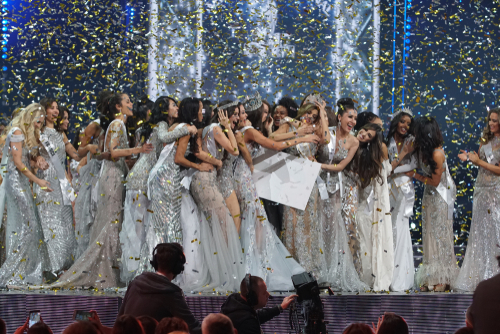In 2018, Miss USA Is Still a Beauty Pageant—but Not the One It Used to Be
Say what you will about pageants—that they’re frivolous, or antifeminist, or that in the early, pre-EPA years, the aerosol hairspray necessary to get through a single show probably wore a tiara-shaped hole in the ozone layer.
But once you’ve run out of of complaints (we’ll wait), consider this: In most spheres of culture, we’ve long retired the premise that a woman who loves fashion and makeup cannot also be smart, that a woman who uses good looks as a lever doesn’t also have something else to leverage. So why should this particular corner of Americana be any different?
Women have dismantled the idea that we cannot be many things at once. And if the Miss USA pageant doesn’t put a fine point on that fact…well, then perhaps you’re not watching closely enough.
Two years out from under its affiliation with Donald Trump, the 2018 version of the competition has worked to distance itself from polarizing politics. This year’s prejudging committee panel is made up entirely of women, and, for the first time in history, committee members and competitors spent the full week together before the pageant, during which time contestants were interviewed, one on one, for judges to get a sense of who they are outside the swimsuit competition.
“Pageants get such a bad rap,” says Lilliana Vazquez, a Today style expert who was tapped to join the committee this year. But, she adds, “I think it’s up to the people who watch pageants and the networks to push change forward. And now is the perfect time to do it.”
“People say, ‘How dare you compete in pageants,’ that they’re not empowering to women, and judging them for that, when all these young women are saying: ‘I got something out of this,” says Miss Universe Organization president Paula Shugart.
In Miss USA what the committee was looking for is “someone who will set the bar even higher and be part of the change going forward,” Vazquez says. That’s pageant speak for: Certainly, while what is skin deep still plays a big part in the pageant, perhaps we need to evolve the way we—as an audience—think about pageants, to include what lies beneath the surface.
“We have 51 contestants here, and they’re not all going to be politically aligned,” says Shugart, but they are expected to understand the political stakes of holding a megaphone. During the interviews every woman was asked about fake news and her thoughts on the major issues plaguing the nation today. “You are responsible, if democracy is going to survive,” Shugart told contestants. “I’m charging them to be an educated electorate.”
These women may be beauty queens, [but] they’re also real people who have experienced adversity in America, and want to share the spotlight with an issue that hits home for them.
But though that’s the charge Shugart is issuing, the truth is that a lot of this crop came to the table already angling to get into the political discourse. Shugart says that, this year in particular, the bent toward activism and advocacy among contestants is more “pervasive” than it has been in the past. And much of that can be attributed to the fact that while these women may be beauty queens, they’re also real people who have experienced adversity in America, and want to share the spotlight with an issue that hits home for them.
Take Caelynn Miller-Keyes—Miss North Carolina—who, according to pageant organizers, became an advocate for sexual assault prevention after being assaulted in college; her activism is aimed toward fostering policies that would make it easier for victims to come forward with their stories, and she is working with attorneys in her home state to address colleges’ policies and protocols under Title IX. Or Laine Mansour, Miss Missouri, who uses her statewide platform to tour a program of her own design: 1st Man Up aims to educate young men about sexual assault and advocates for the respect and support of women, and Mansour travels to schools across the state to help educate boys about how to be a positive force—instead of bystanders.
Vazquez brought up another triumph over adversity that a contestant has turned into activism: “Miss Nevada was homeless, and there’s a massive homelessness issue in her home state,” she said she learned during the time she spent with contestants. Miss Nevada, Carolina Urrea, is an advocate of the Nevada partnership for Homeless Youth (NPHY), and uses her own story to inspire others, and show them that it’s possible, even when things feel dire, for things to change for the better.
Another assumption that even some committee judges held prior to taking up their posts? “I was thinking [there would be] a lot of blonds,” Vazquez says with a laugh.
Growing up in Texas a first generation Mexican American and Puerto Rican, Vazquez was steeped in pageants from the time she was a kid. But despite the population demographics of her home state, “I never saw a Mexican woman compete in Texas, and it made me sad,” she says. “If you don’t see yourself on that state, you don’t think you actually can be on that state.” This year, though, she said she was “blown away” by the diversity of the competitors.
“We have so many first-generation immigrants in this competition,” Vazquez says, “and they’re going to get up on that stage, and represent that state of Georgia, of Alabama—that’s what America looks like.”
And so, if you look closely, beyond the gleaming white teeth, and yes, the parade of toned bodies in bathing suits, you might see another image start to appear: a contingent of women who are using a pageant to push forward an ulterior agenda—one that might make a more resounding impact than an onstage wish for world peace.

